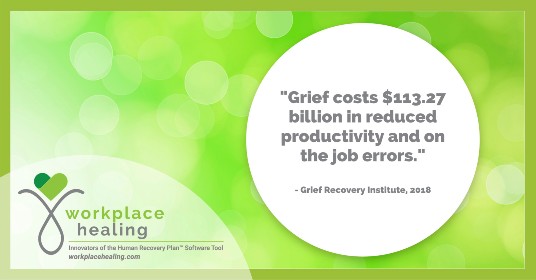
Your Employee’s Brain on Grief
Grief causes temporary, neurochemical changes in the brain that can affect job performance and overall well-being. Learn six ways the impact of grief can have on an employee, and how you can create a more empathetic workplace that supports human recovery.
“One cannot hire a hand, the whole person comes with it.” ~ Peter Drucker
The Impact of Grief
There’s nothing worse than feeling helpless and uncertain about how to support a grieving employee. As a manager, your response is critical to the success and well-being of your employee and your team as a whole.
Employees who feel unsupported by their employer following a grief event are 56% more likely to leave their company. By knowing what to expect from a grieving employee and how to respond, you’ll be more likely to approach the situation with empathy and confidence, helping to retain and re-integrate that employee following a life disruption.
1) Foggy brain.
Sometimes referred to as “grief brain,” people who experience brain fog often struggle to concentrate on and complete tasks. They may have little energy, seem unusually forgetful, and have trouble remembering certain words or phrases. Why?
The brain interprets grief in the same way it would with any stressful event. It sets off a fight or flight response and floods the body with neurochemicals and hormones. Grief affects several regions of the brain, including the limbic system which helps us with emotional regulation and memory, and the prefrontal cortex, which helps us with executive functioning like learning, organizing, planning, and completing tasks.
Tip: Temporarily take over and/or reassign some of your employee’s tasks to others on your team who are willing and able to help. Reducing your employee’s workload can help relieve some of the stress and brain fog your employee might be feeling and decrease the odds of costly mistakes.
2) Disengaged.
Your employee might be physically present and performing their duties but doesn’t seem fully engaged. This phenomenon, which often accompanies brain fog, is called presenteeism and results in decreased job performance.
Imagine suffering from a dull headache at work. You don’t necessarily need to take a sick day, but the discomfort is making it difficult to focus and you feel like you’re operating through a haze of pain. Grief is similar. You’re physically able to be in the office, but you’re having trouble focusing on your work because your mind keeps drifting. Presenteeism can have a drastic effect on workplace productivity, slashing it by one-third or more. (Harvard Business Review)
Tip: Acknowledging an employee’s grief can help you re-engage with them. It shows empathy, helps them feel less alone, and dignifies their loss. Find a quiet, comfortable and private location to talk and listen. Remind them that we all need help during difficult times and that you and the team are there for them.
3) Working too much.
Some people bury their grief in work because work provides a sense of control and helps them feel less anxious. While this kind of coping mechanism is often rewarded in our culture, overworking is detrimental to emotional and physical health, and it does little to benefit your organization’s bottom line. Overworking leads to burnout, lower productivity, missed work due to illness, and on-the-job errors.

Tip: Encourage work-life balance and taking time off for self-care. Normalize discussing grief and healing by checking in with your grieving employee and asking what they are doing to care for themselves.
4) Down and out.
Although grief is universal, it’s an individual experience. While one person might throw themselves into their work to the detriment of their health, another might avoid the workplace altogether.
Unsupported grief at work can result in absenteeism, which costs employers roughly $225.8 billion annually, according to the Centers for Disease Control (CDC).
Aggravating the issue, the *average bereavement leave in the U.S. is between three and seven days, and time off is typically determined according to how you’re related to the deceased. Needless to say, these policies often leave employees cold.
That said, no matter what your organization’s bereavement policy might be, you can take proactive steps to reduce absenteeism and enhance retention and loyalty by providing an empathetic workplace that promotes employee well-being.
Tip: It’s possible to acknowledge any life disruption an employee experiences with empathy, even if it’s a situation you have trouble relating to or haven’t personally experienced yourself. You might say, for example, “I don’t know how you feel, but I am here to offer assistance.” Rather than an environment that comes across as unfeeling and isolating, your employee will see work as a warm extension of their lives that supports their healing.
*Check out this fantastic article from the Wall Street Journal about how bereavement policies are beginning to change!
5) Illness.
Speaking of absenteeism, does it seem like your employee is frequently sick with colds and other ailments? Unprocessed, unacknowledged grief can manifest as physical and emotional troubles, resulting in inflammation, depression, and a weakened immune system.

According to WebMD, grief can show up in the body as headaches, shortness of breath, nausea, chest pain, stomach aches, fatigue, and loss of appetite. For every employee who experiences grief with no support from coworkers or managers, an estimated 30 workdays are lost each year. (Grief Recovery Institute, 2018)
Tip: Self-care and social support are key to grief recovery. As socially evolved beings, our brains crave social support, rewarding us with immune-boosting chemicals and hormones when we connect with others. Something as simple as encouraging your grieving employee to take a walk outside with a considerate colleague can be beneficial to both physical and mental health.
Also, if your company has an Employee Assistance Program (EAP), be sure and let your grieving employee know what benefits and resources are available to them and how to access them.
6) Seeking purpose.
Often described as the sixth stage of grief, a griever searches for renewed purpose and often reevaluates their priorities. Many nonprofits, scholarships, and foundations rise from grief. Workplace Healing itself was born from a personal tragedy followed by a difficult re-entry to corporate life.
Tip: Show your employee that you support them by rallying your team to help raise funds or participate in an event that’s associated with your employee’s loved ones and is meaningful to them, i.e., Alzheimer’s, American Heart Association, Suicide Prevention.
Want to make it easier to support and re-engage a grieving employee?
Check out our innovative Human Recovery Plan™ Software Platform, which was created for corporate managers, supervisors, and care teams to build ahead and heart-based plan that restores an employee’s productivity following a grief event.
To schedule a demo, visit Request for Demo.
